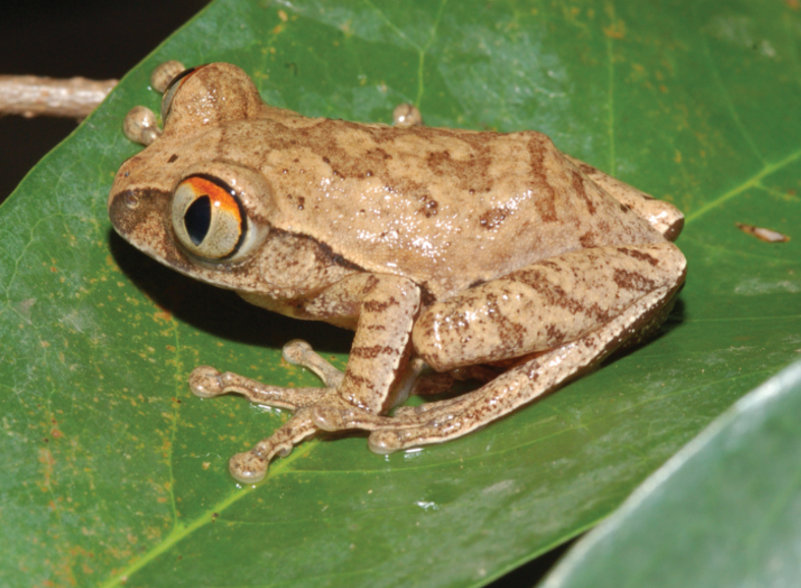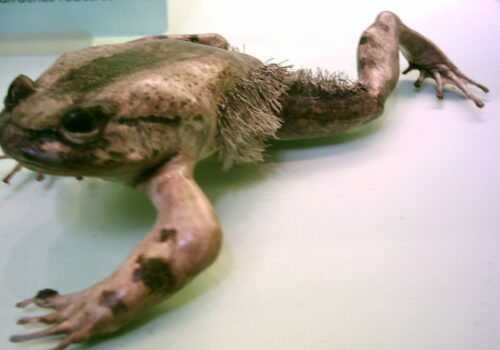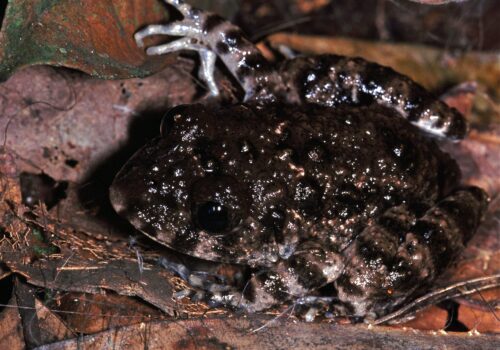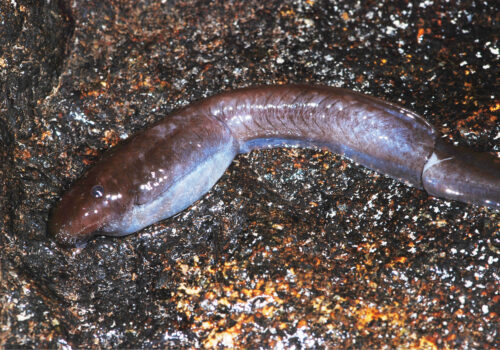- Introduction: A Symphony in African Darkness
- Taxonomy and Classification: Where Does the Spirit Belong?
- Natural Habitat: A Life High in the Canopy
- Physical Characteristics: A Master of Camouflage and Subtle Beauty
- Behavior and Life Cycle: Nocturnal Serenades and Secret Lives
- Ecological Role: Guardians in Delicate Balance
- Threats and Conservation Status: Facing the Shadow of Extinction
- Cultural and Scientific Significance: Echoes Beyond Ecology
- Conclusion: Protecting the Spirit of the African Night
Introduction: A Symphony in African Darkness#
As twilight descends upon the dense rainforests of West Africa, the chorus of nocturnal life awakens. From within this symphonic tapestry, an ethereal, melodious trill emanates high among the branches. This hauntingly beautiful serenade signals the presence of one of the continent’s most evocatively named amphibians: Leptopelis spiritusnoctis, the evocative “spirit of the night.” The name alone conjures mysteries and whispers of moonlit secrets. Although small in stature, this charismatic nocturnal creature plays a significant ecological role, holds the key to untold biological insights, and represents nature’s delicate balance in West Africa’s vulnerable ecosystems.
Join me as we embark on a journey through the shadow-dappled forests of tropical Africa, uncovering the hidden life, intriguing behaviors, enchanting habitats, and crucial conservation concerns surrounding Leptopelis spiritusnoctis.
Taxonomy and Classification: Where Does the Spirit Belong?#
As amphibians belonging to the diverse family Arthroleptidae, Leptopelis species (commonly called forest tree frogs) are widespread across sub-Saharan Africa. The genus Leptopelis encompasses approximately 50 described species, renowned for their adaptability and stunning colors. Amid this genus resides our enigmatic focus, Leptopelis spiritusnoctis, first described scientifically by Rödel in 2007.
Its specific epithet, “spiritusnoctis,” derived from Latin, poetically translates to “the spirit of the night”—an apt reflection of its ghostly melodic calls echoing through the African forests after dark. It shares the genus with familiar and closely related cousins, such as Leptopelis hyloides and Leptopelis macrotis, all characterized by arboreal lifestyles and crepuscular habits.
Natural Habitat: A Life High in the Canopy#
Leptopelis spiritusnoctis thrives primarily within West and Central Africa’s rich rainforests, prominently seen in dense patches of primary and undisturbed secondary forest. Countries including Côte d’Ivoire, Ghana, Guinea, Liberia, Sierra Leone, and Cameroon provide critical shelter for this species. Their preferred habitats feature dense vegetation, humid microclimates, and proximity to freshwater streams or wetlands.
This species is notably arboreal—in other words, impeccably adapted to life above the moist forest floor. While we humans mainly scan for frogs on fallen logs or among leafy litter, Leptopelis spiritusnoctis defies expectations, preferring the safety and richness of tree canopies, several meters above ground. Here, amid tangles of vines and branches, they escape most ground predators, while engaging in nocturnal hunts and intricate courtship rituals.
Forest Architecture and Amphibian Refuge#
The forest canopy provides an intricate ecological architecture, immeasurably vital to animals like Leptopelis spiritusnoctis. Moss and epiphyte-laden branches sustain humid microhabitats perfect for preserving skin moisture crucial to their survival. Stream-edges beneath dense overhead canopies generate the humid air currents frogs require, especially during mating seasons when hydration levels significantly affect egg survival and tadpole development.
Physical Characteristics: A Master of Camouflage and Subtle Beauty#
At dawn, amid foliage glistening with moisture, spotting Leptopelis spiritusnoctis is a rewarding challenge. These frogs are modestly sized, generally measuring between 4 to 5 centimeters long. Their coloration exhibits hues of speckled greens, subtle earth tones, and hints of gray or brown—perfect camouflage among leaves, branches, and lichen-draped branches. Such coloration exemplifies cryptic protection, shielding these frogs from potential predators and allowing stealthy ambushes of insect prey.
Their skin texture is relatively smooth and moist, a necessity to aid breathable skin and moisture retention. Rounded digits capped with disc-like pads make these frogs expert climbers, effortlessly adhering to slippery leaves and slender branches as they move gracefully through the forest canopy.
The large expressive eyes of Leptopelis spiritusnoctis reflect their nocturnal lifestyles; expansive pupils designed to catch the faintest glimmers of starlight exemplify their marvelous adaptation to nighttime visibility.
Behavior and Life Cycle: Nocturnal Serenades and Secret Lives#
Activity peaks as daylight fades. Leptopelis spiritusnoctis emerges into the moonlit forest canopy, orchestrating nocturnal rhythms with their enchanting calls. Male frogs strategically pick elevated positions, calling vigorously to attract mates against vast nighttime symphonies. Their calls— delicate, flute-like whistles interspersed with melodic trills—create a mesmerizing auditory tapestry.
On the Hunt: Feeding Among the Familiar Shadows#
These nocturnal frogs rely predominantly on a diet of insects and other arthropods. Hunting primarily relies on a sit-and-wait strategy, carefully observing for prey within leg-striking range. Rapid, accurate strikes enabled by binocular vision succeed in capturing elusive beetles, moths, crickets, and spiders. Their presence keeps insect populations balanced within complex forest ecosystems.
Romantic Moonlit Rituals: Breeding and Care#
Leptopelis spiritusnoctis relies on specific microhabitats and streamside vegetation for breeding purposes. During rainy periods, eggs are diligently placed in water-filled tree cavities or within damp vegetation hanging above shallow pools. Once hatched, tadpoles gently drop or slide into waters below, where they develop further into froglets, transforming gradually into terrestrial adults. This careful reproductive strategy helps maintain stable populations relative to ecosystem fluctuations.
Ecological Role: Guardians in Delicate Balance#
A healthy amphibian population, including Leptopelis spiritusnoctis, serves as a critical ecological indicator. Frogs and amphibians inevitably reflect the environmental health of their habitats, responding swiftly to changes in water purity, deforestation, and shifts in temperatures and humidity. Moreover, they play the dual roles of predator and prey, helping regulate insect populations while also supporting predator species such as snakes, birds, and small mammals. Hence, protecting the night-spirits stabilizes entire forest ecosystems.
Threats and Conservation Status: Facing the Shadow of Extinction#
Sadly, despite their adaptability in undisturbed habitats, the relentless pressures of deforestation, habitat fragmentation, agriculture expansion, and climate changes jeopardize populations of Leptopelis spiritusnoctis. The IUCN currently classifies this species under the status “Least Concern,” primarily due to their broad distribution; however, conservationists warn that continued unchecked habitat degradation could quickly elevate concerns.
Guardians at Work: Conservation Initiatives#
Local and international conservation entities have initiated protective actions in forested regions crucial to Leptopelis spiritusnoctis’ survival. Education campaigns, habitat restoration projects, and sustainable forestry incentives collectively aim to slow deforestation while promoting awareness of amphibian significance. Ultimately, effective conservation underscores a global responsibility to maintain biodiversity and sustain ecological harmony.
Cultural and Scientific Significance: Echoes Beyond Ecology#
The alluring nocturnal melodies of Leptopelis spiritusnoctis echo deeply within cultural imagination and traditional lore. Indigenous communities often view nighttime calling frogs symbolically, connecting their presence to spiritual guidance, rain predictions, and ecological fortunes.
Scientifically, their resilience in specific microhabitats makes them an invaluable model species to study impacts of climate change and environmental stressors. Unlocking their biological secrets yields deeper insights within ecological conservation efforts.
Conclusion: Protecting the Spirit of the African Night#
As midnight envelops African rainforests in velvet shadow and distant stars illuminate the darkness, the mesmerizing melodies of Leptopelis spiritusnoctis continue weaving their song—every call a testament to fragile wilderness still fighting for survival.
Protecting this enchanting “spirit of the night” ensures the preservation of a rich tapestry of life beneath African skies. Beyond ecosystems and biodiversity, safeguarding Leptopelis spiritusnoctis affirms our commitment to sustaining the harmonious symphony that makes our world inherently beautiful.
Join the voices advocating its protection, engage in habitat preservation actions, and champion for the delicate lives hidden within forest darkness—because within nightfall lies nature’s most compelling symphony.


















